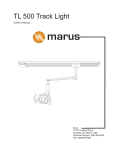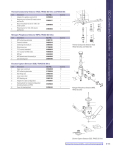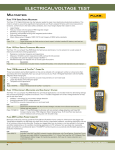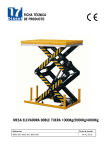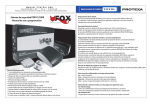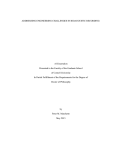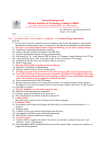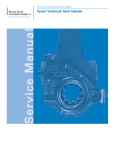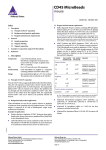Download Marus CL1000 Owner`s manual
Transcript
CL1000 Ceiling Light OWNER’S MANUAL Marus 11727 Fruehauf Drive Charlotte, NC 28273 USA Warranty The Marus Light was thoroughly inspected and tested in accordance with rigid specifications and standards of Marus quality. All of our products sold to and installed by dealers are guaranteed to be free from defects in workmanship and materials for five years from date of purchase - providing all installation and service is done in accordance with procedures as outlined in our instructions. During that period, we will replace any defective part at no charge. We WILL NOT be responsible for dealer or service company labor charges or shipping charges to the Marus factory. This guarantee does not cover normal wear, stains, cuts or scratches of surface finishes or parts sold to O.E.M. customers. Staining, discoloration, or deterioration of the equipment caused by disinfectant solutions is not covered under the warranty. We will pay the return freight charges from the factory to the dealer. This guarantee does not cover damage resulting from improper installation, misuse, or accidents incurred in shipping and handling. All claims against the freight carrier must be initiated at the time the damaged items are received. The claim is the responsibility of the customer. We are constantly striving to improve our products. Therefore, we reserve the right to make modifications without the need for prior notification. Nor are we obliged to modify previously manufactured items. It is the user’s responsibility to read and understand the contents of this manual. This manual contains important information relative to hazards to personnel and property if this equipment is not installed, used and/or maintained as instructed. Technical Support Tech Support: 800-304-5332 FAX: 888-861-9366 Web site: www.marus.com Marus 11727 Fruehauf Drive Charlotte, NC 28273Printed in the U.S.A. 70-050R228 Rev 11 02/12 Table of Contents General Information................................................................................................................................ 2 Definition of Symbols....................................................................................................................... 2 Product Disposal.............................................................................................................................. 2 Interference with Electromedical Devices........................................................................................ 2 Incompatible Devices and/or Accessories....................................................................................... 2 Obtaining Technical Literature.......................................................................................................... 2 Product Identification....................................................................................................................... 2 Safety Notes........................................................................................................................................... 3 Storage Conditions.......................................................................................................................... 3 Technical Specifications for the Dental Light.......................................................................................... 4 Technical Description — Light.......................................................................................................... 4 Electrical Specifications................................................................................................................... 4 Light Specifications.......................................................................................................................... 4 Replacement Parts for Dental Lights............................................................................................... 4 Safety Markings............................................................................................................................... 4 Device Classification........................................................................................................................ 4 Cleaning the Light................................................................................................................................... 5 WARNINGS, DISINFECTING & STERILIZATION - LIGHTS........................................................... 5 Infection Control............................................................................................................................... 5 Chemical Disinfection....................................................................................................................... 5 Unacceptable Disinfectants.............................................................................................................. 5 Conditionally Acceptable Disinfectants*........................................................................................... 5 Cleaning Reflector and Cover.......................................................................................................... 6 Cleaning Painted Surfaces............................................................................................................... 6 Dimensions............................................................................................................................................. 7 Suggested Mounting Methods................................................................................................................ 8 Suggested Installation on Wood Framed Ceiling............................................................................. 9 Wood Structure for Suspended Ceiling.......................................................................................... 10 Suggested Installation on Suspended Ceiling............................................................................... 10 Metal Structure for Suspended Ceiling.......................................................................................... 11 Electrical Requirements....................................................................................................................... 11 Ceiling Light Installation Instructions.................................................................................................... 12 Overview / Replacement Parts....................................................................................................... 15 Controls................................................................................................................................................ 15 On-Off Switch................................................................................................................................. 15 Intensity Switch.............................................................................................................................. 15 Spare Bulb..................................................................................................................................... 15 Bulb Removal and Replacement.................................................................................................... 16 Light Focus Adjustments...................................................................................................................... 17 Yoke Pivot Friction Adjustment............................................................................................................. 17 Flex Arm Adjustment............................................................................................................................ 19 Electromagnetic Compatibility.............................................................................................................. 20 Electrical Schematics........................................................................................................................... 24 Checklist............................................................................................................................................... 26 1 General Information Definition of Symbols The following symbols may be used throughout this manual: CAUTION. Failure to carefully follow the described procedure may result in damage to the equipment. WARNING. Failure to carefully follow the described procedure may result in damage to the equipment and/or operator/patient injury. Risk of electrical shock present. Ensure power is disconnected before attempting this procedure. Product Disposal Contact your local authorized dealer for proper disposal of the device to ensure compliance with your local environmental regulations. Interference with Electromedical Devices To guarantee the operational safety of electromedical devices, it is recommended that the operation of mobile radio telephones in the medical practice or hospital be prohibited. Strong EMI sources such as electro surgery units or x-ray units may affect performance. If performance problems occur, move the light to another electrical circuit or physical location. Incompatible Devices and/or Accessories Protective Earth (Ground) For reasons of product safety, only original manufacturer devices & accessories approved for this product, or accessories from third parties which have been released by the manufacturer may be used. It is the user’s risk when using non-released accessories are used. Manufacturing date Obtaining Technical Literature AC (Alternating Current) Waste Electrical and Electronic Equipment Type B Equipment (Protected against electrical shock) Dangerous Voltage Electrical Testing Lab The manufacturer will make available on request circuit diagrams, component parts lists, descriptions, calibration instructions or other information that will assist technical personnel to repair and replace serviceable items. Product Identification This dental light can be identified by its product label, located on product. This label states the light model and serial number, electrical specifications, manufacture date and safety classification. Note the SAMPLE labels shown below. Identification mark that indicates the product complies with the health & safety requirements as published by European Directives. Marus MN SN Authorized European Representative: Dental Light 2 MN SN Dental Light 230 VAC, 50HZ, 0.6A IEC Type B, Class 1, IPX4 92163 • Rev.5 • 02/12 Operation Mode: Intermittent Conforms to: EN60601-1-2,UL60601-1 Certified to: CAN/CSA - C22.2 NO.601.1 59768 WARNING: This product is intended for use by trained dental/medical professionals only. 11727 Fruehauf Drive Charlotte, NC 28273 USA 115 VAC, 60HZ, 1.09A IEC Type B, Class 1, IPX4 92162• Rev.5 •02/12 Medical Device and QA Services 76, Stockport Road WA15 7SN United Kingdom e-mail: [email protected] Marus 11727 Fruehauf Drive Charlotte, NC 28273 USA Operation Mode: Intermittent Conforms to: EN60601-1-2,UL60601-1 Certified to: CAN/CSA - C22.2 NO.601.1 59768 Safety Notes The pre-installation must be performed according to the requirements in our ‘Pre-installation Instructions’. As manufacturers of electro-medical products we can assume responsibility for safety-related performance of the equipment only if maintenance, repair and modifications are carried out only by us or agencies we have authorized for this purpose, and if components affecting safe operation of the unit that may be needed are replaced with original parts. We suggest that you request a certificate showing the nature and extent of the work performed, from those who carry out such work, and specify that the certificate show any changes in rated parameters or working ranges, as well as the date, the name of the firm and a signature. WARNING: Rotational stops are designed for a maximum force limit of 30 lbs. If rotational stops are broken immediately take the equipment out of use and have the equipment serviced. Operation of damaged equipment could result in injury to the operator and/or patient. WARNING: Failure to install set screws & roll pin per Installation Instructions could result in injury or damage to equipment. WARNING: The light is not to be used in rooms where an explosion hazard exists. WARNING: Power cords and their associated parts cannot be substituted without increased risk of electric shock or fire. Use manufacturerapproved replacement parts only! Power cords must be installed by qualified personnel. Make sure all service loops, strain reliefs, and cord guards are in place and that line, neutral and ground wires are secured. CAUTION: Only authorized service technicians should attempt to service this equipment. Use of other than authorized technicians will void the warranty. WARNING: Failure to disinfect the dental operating light between patients could expose user/patient to cross contamination and bio-burden/biocontamination. WARNING: No modification of this equipment is allowed. CAUTION! Use a licensed electrician for all wiring. WARNING: To avoid risk of electric shock, this equipment must be connected only to supply mains with protective earth. WARNING: To avoid risk of burn injuries do not touch the light reflector during operation. WARNING: To avoid risk of injury, avoid contact with sharp edges on dental lights. WARNING: This product must be disinfected before use. Storage Conditions: -55°C to +50°C 10% to 90% Relative Humidity 3 Technical Specifications for the Dental Light Technical Description — Light The dental light is used for illuminating the oral cavity during the performance of dental procedures. The position and direction of the light can be adjusted as needed by the dentist. The light source is a halogen bulb designed to operate on low voltage. It has two intensity settings. The low voltage is supplied through a transformer which is located at the top of the light pole or in the junction box. Cycles 60 HZ 50 HZ The following represents a condensed list of replacement parts that may be consumed during normal use. See your dealer for a more comprehensive list of components. PART # DESCRIPTION 70-22186���������������� REFLECTOR, GLASS 70-20289���������������� LIGHT SHIELD 70-30441���������������� REPLACEMENT BULB 70-014R304������������ FUSE, 4 AMP, 3 AG (115V) 70-014R303������������ FUSE, 2 AMP, 3 AG (230V) Safety Markings Electrical Specifications Volts Dental light: 115 VAC 230 VAC Replacement Parts for Dental Lights Amps 1.09 A ~ 0.6 A ~ The following warning label may be located on or near the light’s transformer enclosure: Replacement fuses for unit light (located in panel near transformer): 115V: 4 AMP, 3 AG (P/N 70-014R304) 230V: 2 AMP, 3 AG (P/N 70-014R303) IEC Medical Device Classification Classification: 1 Type: B Operation Mode: Intermittent Splash Protection: IPX4 Light Specifications Halogen Lamp: 24 Volts, 100 Watts Input Voltage: 110V/220 V, 60/50 Hz Output Voltage: High 23V, Low 21V Color Temperature: 4500 Degrees Kelvin Light Intensity (Lux): High 25,000, Low 18,500 4 Focal Distance: 27 in. Illumination Area: 3 in. x 8 in. at Focal Distance Approx. Weight: 9.09 kg. (20 lbs.) Technical Information Device Classification The dental light is classified as Class 1 device under rule FDA CFR 21, Class I device under Health Canada guidelines, and a Class I device under rule 11 of the MDD 93/42/EEC of Annex IX. Cleaning the Light The equipment can be cleaned with a solution of mild detergent and warm water. A variety of surface disinfectants are available for use in dental treatment rooms. Some of these can cause discoloration of painted, plated or anodized surfaces with repeated use. This can be minimized by careful adherence to the disinfectant manufacturer’s instructions and by frequent washing with soap and water. If you use an iodophor, it is especially important that you follow up with an iodophor neutralizer. IMPORTANT: Do not use powdered cleansers, scouring pads or abrasive scrubbers on any of the painted, plastic or metal surfaces of this light. To remove dried-on material, use a soft bristled brush and a solution of mild detergent. WARNINGS, DISINFECTING & STERILIZATION - LIGHTS Infection control in the dental office continues to be a high priority for our customers and end users. OSHA, the ADA and the CDC are also involved in this complex issue. The Manufacturer will not attempt to specify the required intervals for disinfection nor can it recommend the overall best surface disinfectant. Please refer to the: Infection Control Recommendations published by the American Dental Association for further information. The question is often asked, “What should I use to disinfect my dental unit, chair and light?” This question is more complex than it seems because of the wide variety of products on the market as well as formulations of the products changing to meet the needs of increased asepsis. barriers should be used and changed between patients. The barrier technique will ensure maximum long term durability of the surfaces and finishes of the equipment. Chemical Disinfection Regardless of the chemical disinfectant used, it is imperative that the equipment be thoroughly washed with mild soap and warm water at least once per day. This wash down will minimize the harmful effects of chemical disinfectant residues being allowed to accumulate on the equipment. When using chemical disinfectants, always pay strict attention to the manufacturer’s disinfectant directions. When using concentrated disinfectants, measure the concentrate carefully and mix according to package directions. Disinfectant solutions that are relatively harmless to surfaces at their recommended strengths can be corrosive at higher than recommended dilution ratios. Barrier Technique The Manufacturer strongly advocates the barrier technique be used whenever possible to preserve the finish and appearance of the equipment. Wherever possible disposable Unacceptable Disinfectants These disinfectants will harm the surface finishes of dental equipment and are not recommended. Use of these products will void your warranty. Chemical Composition Strong Phenols/Phenol Alcohol combinations Sodium Hypochlorite/Household Bleach Sodium Bromide Strong Alcohol Household Cleaners (Dental Equipment Only) Citric Acids Iodophors** Ammonium Chloride Accelerated Hydrogen Peroxide (0.5%) Conditionally Acceptable Disinfectants* These disinfectants have been found to be the least harmful to the equipment surfaces by our test methods. Chemical Composition Phthalaldehyde Quaternary Ammonium Glutaraldehyde CAUTION Only disinfect by wiping, no spray disinfection. Please be aware that the manufacturer expressly rejects any claims for warranty or damages when using other cleaning and disinfections solutions. warranty expressed or implied that these disinfectants will not damage the surface finishes. Damage and discoloration of the surface finishes are not covered under the warranty. *The Manufacturer makes no representation as to the disinfectant efficacy of these products. We make no **Iodophor-based disinfectants will cause yellow staining on many surfaces. 5 CLEANING YOUR LIGHT Cleaning Reflector and Cover NOTE: Use only denatured alcohol to clean the glass reflector. Use only mild soap and water to clean the plastic reflector cover. Do not use any solvents, abrasives, abrasive cloths or cleaners, as they may damage the coated surface of the reflector. Be sure the electrical supply is turned off and the light is cool before attempting any cleaning or polishing. Remove the bulb shield, cover and bulb for full access to the reflector. (See “Bulb Replacement” for bulb removal). Use a clean, soft** facial tissue dampened with denatured alcohol and gently wipe the surface of the reflector and the bulb. The plastic reflector cover may be gently washed with soap and water and dried using a soft towel. Cleaning Painted Surfaces The painted surfaces of your light can be cleaned by simply wiping with a damp cloth. No other protective coating is required to preserve the permanent luster of the painted surface. CAUTION: Placing aluminum foil over the lamp handles for barrier asepsis will cause permanent discoloration of the handles. We recommend covers specifically manufactured for this purpose. Discoloration of the handles caused by the above is not covered under warranty. **We recommend Puffs facial tissues. NOTE: The plastic reflector cover must always be in place when light is used because it will catch bulb particles in the rare event a bulb should break; also, it will keep abrasive material away from the coated surface of the reflector. 6 Dimensions 12” 21-1/2” - 26” 23 1/2” 28” TRAVEL Figure 1 Location A typical location for mounting the ceiling mount light is relation to the dental chair for a right-handed operator is shown in Figure 2. Mounting for a left-handed operator would be mounted on the opposite side of the chair. This mounting location can be altered to suit the individual’s preference or the building construction. Height The maximum ceiling height that can be accommodated by available suspension tubes is 10’-6”; the minimum being 8’. Refer to the chart for proper suspension tube to use. Suspension Tube Chart Ceiling Height Tube Part No. Length (inches) 8’ 52R252-1 17” 8’6” 52R270-1 23” 9’ 52R271-1 29” 9’6” 52R272-1 35” 10’ 52R273-1 41” 10’6” 52R274-1 47” 7 Suggested Mounting Methods TYPICAL POSITION OF CEILING MOUNT IN RELATION TO DENTAL CHAIR 12” MOUNTING LOCATION FOR RIGHT-HANDED OPERATOR 18” 18” 12” Figure 2 8 MOUNTING LOCATION FOR LEFT-HANDED OPERATOR Suggested Installation on Wood Framed Ceiling CEILING JOISTS 16” O.C. 1 INCH MOUNTING PLATE w/ COLLAR POWER SUPPLY CONDUIT FINISHED CEILING MATERIAL POWER CONDUIT COMES THROUGH HOLE 2-1/2” OFFSET FROM CENTER. NEW CONSTRUCTION Figure 3 CEILING JOISTS 16” O.C. 1 INCH 36” x 16” x 3/4” PLYWOOD OVER FINISHED CEILING Figure 4 (6) 1/4” LAG SCREWS 3” LONG EXISTING CONSTRUCTION 9 Suggested Installation on Suspended Ceiling SUGGESTED INSTALLATION ON SUSPENDED CEILING SUGGESTED INSTALLATION ON SUSPENDED CEILING FIXED CEILING FIXED CEILING CEILING JOIST MOUNTING PLATE w/ COLLAR & POST CEILING JOIST MOUNTING PLATE w/ COLLAR & POST SUSPENDED CEILING COVER SUSPENDED CEILING COVER MOUNTING PLATE w/ COLLAR & POST MOUNTING PLATE w/ COLLAR & POST SUSPENDED CEILING COVER SUSPENDED CEILING COVER FIGURE 5 - ATTACHING COVER FIGURE 5 - ATTACHING COVER FOR SUSPENDED CEILING Wood StructureWOOD for STRUCTURE Suspended Ceiling WOOD STRUCTURE FOR SUSPENDED CEILING CEILING JOISTS CEILING JOISTS SUSPENDED CEILING SUSPENDED CEILING MOUNTING PLATE w/ COLLAR & POST COVER MOUNTING PLATE w/ COLLAR & POST COVER CEILING JOISTS CEILING JOISTS 1-1/2” THICK PLYWOOD 1-1/2” THICK PLYWOOD FIGURE 6 FIGURE 6 10 BE SURE TO BRACE IN BOTH DIRECTIONS BE SURE TO BRACE IN BOTH DIRECTIONS Metal Structure for Suspended Ceiling USE METAL MASONRY ANCHOR WHEN REQUIRED 3/8” BOLTS FINISHED CEILING SUSPENDED CEILING LEVELING PLATE 1-1/2” x 3/4” x 1/8” CHANNELS WELDED TO PLATE STEEL PLATE 1/8” THICK COVER (6) 3/8” BOLTS EACH BOLT MUST SUPPORT AT LEAST 75 LBS. FIGURE 7 Electrical Requirements The 115VAC/230VAC service line for the ceiling light should be evaluated and installed by a licensed electrician in accordance with local electrical codes. We recommend that a wall switch be installed in the power supply to facilitate servicing and protect the light transformer in the vent of power surges while the light is not in use (i.e electrical storms). 11 Ceiling Light Installation Instructions 1. Refer to figure #2 for proper location of the ceiling light in relation to the dental chair. Although traditional methods dictate mounting the light to the left side of the chair for a right-handed operator and vice-versa for left-handed, careful consideration should be given to mounting location, especially to prevent interference with x-ray units. Also consider which side of the chair the patient enters. The light will function and position the same regardless of which side of the chair it is mounted on. Evaluate the construction of the ceiling. See included drawings for suggestions on the best support method to use, based on whether you have a conventional or suspended ceiling. 2. After the required support structure is in place, locate and remove from the shipping box the following items: A. Ceiling mounting plate B. Ceiling post C. Installation hardware kit 3. Attach the ceiling mount plate to the support structure using the supplied lag screws or other appropriate hardware as dictated by support method employed. Be certain that the hardware employed can withstand a force of 75 lbs. at each attachment point. 4. Route the power cord through the ceiling post and slip the post into the socket on the ceiling plate. Align the retainer bolt holes in the post with the holes in the post socket and install the retainer bolt. Tighten firmly. (See figure 9). 5. Level the post front to back. Move the level 90 degrees and repeat the above procedure with the remaining screws for leveling side to side. Recheck level in both directions; then fully tighten all leveling screws ( A magnetic level works best). 6. Turn the power to the ceiling light circuit off and make the necessary electrical connections. We recommend that a licensed electrician make the required power connections (See figures 9 & 10). 7. Place the mounting plate cover halfway up the ceiling post with the cover retaining collar below it. Lightly tighten the setscrew to temporarily hold the cover in position. CAUTION: Do not overtighten the set screw. It will mark the painted post. 8. Place the locking tab retaining collar on the post just above the locking tab slot and lightly tighten the set screw (See cautionary note in Step 7). Install the stop screw in the light adapter according to which side of the chair the light is mounted on. (See figure 10). 9. Grease the light adapter and the inside of the bottom of the ceiling post using supplied lubricant. Have an assistant hold the light assembly with the adapter near the bottom of the ceiling post. Plug the short male cord into the female coiled cord firmly, being certain that this plug makes a tight connection so as not to become disconnected in the future. 10. Slide the light adapter into the bottom of the ceiling post until it bottoms. Look into the slot to be sure the stop screw is not within the confines of the slot. Now place the locking tab into the slot in the side of the ceiling post. (See figure 10). The locking tab fits flush into the ceiling post. Now loosen the set screw on the locking tab retaining collar and lower it over the slot. Align the collar with the bottom of the post and tighten the set screw firmly. The assistant supporting the light can now release it. 12 11. Check the light for freedom of movement and for any drift when positioned. Recheck the post and make any necessary leveling adjustments. Raise the ceiling plate cover to the top of the pole and tighten the set screw of the cover stop collar to hold the cover in place. 12. Turn on the power switch and check the light for proper operation. The switch has three positions: high, medium, and low. The light is factory preset at a 27” focal distance. This can be adjusted to suit the operators preference. 13. On some applications in offices with low ceilings, an over travel stop may be needed to prevent contact with the ceiling. This is supplied in the installation kit. (See figure 8). Figure 8 13 Power Supply Access Hole Ceiling Mounting Plate Junction Box Safety Bolt Post Socket Suspension Tube or Ceiling Post (Refer to chart on Pg. 4) Ground Terminal Stop Collar Ceiling Plate Cover Coiled Cord Figure 9 Locking Tab Retaining Collar Set Screw Suspension Tube or Ceiling Post (Refer to chart on Pg. 4) Locking Tab Apply Lubricant Retaining Ring Light Adapter Stop Screw Figure 10 14 Overview / Replacement Parts Cover 52R523-1 Set Screw 022R046 Set Screw 022R006 Cover Retainer 52R256 Front End Cap 52R110 Rear End Cap 52R121 Bushing Retainer 52R255 Lower Transformer Cover 22097 End Cap 52R170 Upper Transformer Cover 52R146 Bezel 52R450 Serial# / Model# On / Off Switch 52R442 Spare Bulb Intensity Switch 014R306 Light Handle 52R438-1 Yoke Pivot Cap 22076 Reflector Shield 52R430 Lamp Shield 85R209 Lamp 014R207 Reflector 52R412 Figure 11 Controls On-Off Switch The on-off switch is located on the control panel directly above the light reflector. The long toggle provides easy, one-motion movement to “flick” the light on or off. When the handle is in the up position, the light is on, the down position turns the light off. Intensity Switch A 3-position, rocker-type switch is located adjacent to the on-off switch on the control panel. Depressing the upper portion of the switch places the intensity control in the “HIGH” position allowing the light to emit its maximum brilliance. An intermediate or “MEDIUM” intensity is obtained by placing the switch in the in-between position and the lowest intensity by depressing the lower portion of the switch. Spare Bulb The Marus light is equipped with a spare bulb in the rear of the light head. If the bulb should happen to fail, replace it with the spare bulb provided. See Bulb Replacement section, page 16. 15 Adjustments Bulb Removal and Replacement Note: For maximum reliability and optimum operation, always use Marus replacement bulb #014R207. WARNING! Do not attempt to remove the bulb for 2 minutes after the light has been turned off or until the bulb has cooled. To Remove Bulb The bulb shield is secured by a twist-lock. To remove the shield, twist counterclockwise and pull straight outward until it clears the bulb and reflector shield and let hang on the tether out of the way; then lift off the cover. The bulb is a two-prong push-in type with one prong larger than the other to prevent improper installation. To remove the bulb, grasp the base of the bulb and pull straight outward; a slight side-to-side rocking motion will work the bulb loose. Always grasp the bulb by the base when inserting. Do not touch bulb or reflector. If the bulb or reflector have been handled or touched, they MUST be wiped clean using denatured alcohol before putting into operation. Turn 1/8 Clockwise to lock - logo should be level Tether Figure 12 To Replace Bulb Grasp the bulb by the base, align the matching pins and holes and press the bulb in firmly until it bottoms. Wipe the glass portion clean with denatured alcohol. Place the reflector cover over the reflector and replace the bulb shield in the reverse manner from which it was removed. Replace the shield by pushing it straight in and twisting 1/8 turn clockwise. BE CERTAIN THE BULB SHIELD IS LOCKED SECURELY IN PLACE PRIOR TO OPERATING THE LIGHT! The logo on the front of the bulb shield will be straight and level when the shield is correctly locked in place. 16 Light Focus Adjustments Note: Focus adjustment should be checked each time a new bulb is installed. 1. Place a white paper or cardboard sheet in front of the light* 27 inches from the foremost surface of the bulb shield (or turn the light toward wall at the same distance). 2. Turn the knob at the rear of the light frame as shown in figure 13. *Adjustment may be made any distance from 24 to 39 inches if operator prefers a different focal distance. 3. Turn the knob clockwise or counter-clockwise until the sharpest pattern is obtained at the desired range. Figure 13 Yoke Pivot Friction Adjustment Vertical Note: If the light head pivots too freely vertically, an adjustment can be made at the location shown above on either side of the light. 1. Remove the yoke cap on both sides of the yoke by pulling them straight out. 2. Loosen the two set screws about 1-1/2 turns (one on each side) at the yoke pivot using a 1/16 hex head wrench. 3. Use a common screwdriver to tighten the yoke pivot adjustments. Tighten each side equally. Do not over tighten. Be careful not to damage the wires that come through the yoke pivot adjustment screws. 4. Retighten the set screw and replace the yoke caps. 17 Yoke Pivot Friction Adjustment Horizontal Note: If the light head pivots too freely horizontally, an adjustment can be made as follows: 1. Remove the four screws located at the rear of the light head using a 7/64 hex head wrench. Remove the rear cover (see figure 14). Adjust the tension screw until the desired tension is set. 2. Replace rear cover and install the four screws. The 2 longer screws go on top and the shorter screws go on the bottom. Figure 14 18 Flex Arm Adjustment Vertical 1. Remove the two flex arm cover screws using a flat head screwdriver. (See figure 15). 2. Remove the flex arm cover. 3. Using a 1/2” wrench or socket, adjust the tension bolt until the desired tension is set. Turn clockwise for more tension, counter-clockwise for less tension. 4. Replace cover and end caps. FLEX ARM COVER TENSION BOLT Figure 15 Horizontal Note: Flex arm sways from side to side and will not hold a steady position. 1. Make certain that the horizontal solid arm is level. (See figure 16). Figure 16 19 ELECTROMAGNETIC COMPATIBILITY MEDICAL ELECTRICAL EQUIPMENT ELECTROMAGNETIC COMPATIBILITY (Instructions for use) ELECTROMAGNETIC COMPATIBILITY Electrical medical devices are subject to special EMC safety measurements and as a result the equipment must be installed according to the installation instruction manual. PORTABLE ELECTRONIC DEVICES Portable and mobile high frequency electronic communications equipment may interfere with electronic medical devices. STATIC SENSITIVE DEVICES Where labeled this equipment contains static sensitive devices that require special precautions when handling. At a minimum a grounded wrist strap that is connected to ground stud should be worn to reduce the possibility of damage to the light. MEDICAL ELECTRICAL EQUIPMENT ELECTROMAGNETIC COMPATIBILITY (TECHNICAL DESCRIPTION) ATTENTION OBSERVE PRECAUTIONS FOR HANDLING ELECTROSTATIC SENSITIVE DEVICES ELECTROMAGNETIC COMPATIBILITY testing has been done for this product. ACCESSORY USE Using accessory devices not specified by the manufacturer for use with their equipment may result in an increase of electromagnetic emissions and/or a decrease in electromagnetic immunity of the system. Do not use any accessories not authorized or approved by the manufacturer. INTERFERENCE FROM OTHER EQUIPMENT If other equipment is used adjacent to or stacked with this equipment the system must be observed to verify normal operation. 20 ELECTROMAGNETIC COMPATIBILITY Guidance and manufacturer‘s declaration-electromagnetic immunity This product is intended for use in the electromagnetic environment specified below. The customer or the user of this product should ensure that it is used in such an environment. IMMUNITY TEST IEC60601 TEST LEVEL COMPLIANCE LEVEL ELECTROMAGNETIC ENVIRONMENT GUIDANCE ELECTROSTATIC DISCHARGE (ESD) IEC 61000-4-2 61000-4-2 +/-6 kV contact +/-8 kV air ELECTRICAL FAST TRANSIENT/BURST IEC 61000-4-4 +/-2 kV for power supply lines +/-2 kV for power supply lines +/-1 kV for input/output lines Not applicable, No I/O lines Mains power quality should be that of typical commercial or hospital environment. SURGE IEC 61000-4-5 +/-1 kV differential mode +/-2 kV common mode +/-1 kV differential mode +/-2 kV common mode Mains power quality should be that of typical commercial or hospital environment. VOLTAGE DIPS, SHORT INTERRUPTIONS AND VOLTAGE VARIATIONS ON POWER SUPPLY INPUT LINES IEC 61000-4-11 <5% UT (>95% dip in UT) for 0.5 cycle <5% UT (>95% dip in UT) for 0.5 cycle 40% UT (60% dip in UT) for 5 cycles 40% UT (60% dip in UT) for 5 cycles 70% UT (30% dip in UT) for 25 cycles 70% UT (30% dip in UT) for 25 cycles <5% UT (>95% dip in UT) for 5 seconds <5% UT (>95% dip in UT) for 5 seconds Mains power quality should be that of typical commercial or hospital environment. If the user requires continued operation during power mains interruptions, it is recommended that the product be powered by an uninterrupted power supply or battery. 3 A/m 3 A/m POWER FREQUENCY (50/60 HZ) MAGNETIC FIELD IEC 61000-4-8 +/-6 kV contact +/-8 kV air Floors should be wood, concrete or ceramic tile. If floors are covered with synthetic material the relative humidity should be at least 30%. Where labeled, a ground strap (connected to ground lug) should be worn to reduce the possibility of damaged to the unit when servicing. Power frequency magnetic fields should be at levels characteristic of a typical location in a typical commercial or hospital environment. UT is the AC. mains voltage prior to application of the test level. 21 ELECTROMAGNETIC COMPATIBILITY Guidance and manufacturer's declaration-electromagnetic immunity This product is intended for use in the electromagnetic environment specified below. The customer or the user of this product should assure that it is used in such an environment. Immunity Test IEC60601 Test Level Compliance Level ELECTROMAGNETIC ENVIRONMENT GUIDANCE Portable and mobile RF communications equipment should be used no closer to any part of the product, including cables, than the recommended separation distance calculated from the equation applicable to the frequency of the transmitter. Conducted RF IEC 61000-4-6 3 Vrms 150 kHz to 80 MHz 3 Vrms Radiated RF IEC 61000-4-3 3 V/m 80 kHz to 2.5 MHz 3 V/m d= 1.2 √¯ P 80 MHz 800 MHz d= 2.3 √¯ P 800 MHz 2.5 GHz Where P is the maximum output power rating of the transmitter in watts (W) according to the transmitter manufacturer and d is the recommended separation distance in meters (m). Field strengths from fixed RF transmitters, as determined by an electromagnetic site survey, (a) should be less than the compliance level in each frequency range. (b) Interference may occur in the vicinity of equipment marked with the following symbol: NOTE 1: At 80 MHz to 800 MHz, the higher frequency range applies. NOTE 2: These guidelines may not apply in all situations. Electromagnetic propagation is affected by absorption and reflection from structures objects and people. a) Field strengths from fixed transmitters, such as base stations for radio (cellular/cordless) telephones and land mobile radios, amateur radio, AM and FM radio broadcast and TV broadcast cannot be predicted theoretically with accuracy. To assess the electromagnetic environment due to fixed RF transmitters, an electromagnetic site survey should be considered. If the measured field strength in the location in which the product is used exceeds the applicable RF compliance level above, the product should be observed to verify normal operation. If abnormal performance is observed, additional measures may be necessary, such as re-orienting or relocating the product. b) Over the frequency range 150 kHz to 80 MHz, field strengths should be less than 3/Vm. 22 ELECTROMAGNETIC COMPATIBILITY Guidance and manufacturer‘s declaration-electromagnetic emissions This product is intended for use in the electromagnetic environment specified below. The customer or the user should assure that it is used in such an environment. Emissions Test Compliance Electromagnetic Environment guidance RF emissions CISPR-11 Group 1 This product uses RF energy only for its internal function. Therefore, the emissions are very low and are not likely to cause any interference in nearby electronic equipment. RF emissions CISPR-11 Class B This product is suitable for use in all establishments, other than domestic establishments and those directly connected to the public low voltage power supply network that supplies buildings used for domestic purposes. Harmonic Emissions IEC 61000-3-2 Class A Voltage Fluctuations / flicker Emissions IEC 61000-3-3 Complies Guidance and manufacturer’s declaration-electromagnetic emissions This product is intended for use in the electromagnetic environment specified below. The customer or the user should assure that it is used in such an environment. Emissions Test RF emissions CISPR-11 RF emissions CISPR-11 Harmonic Emissions IEC 61000-3-2 Voltage Fluctuations/ Flicker Emissions IEC 61000-3-3 Compliance Group 1 Class B Class A Electromagnetic Environment guidance This product uses RF energy only for its internal function. Therefore, emissions are very low and are not likely to cause any interference in nearby electronic equipment. This product is suitable for use in all establishments, other than domestic establishments and those directly connected to the public low voltage power supply network that supplies buildings used for domestic purposes. Complies 23 Electrical Schematics 230V 115V 0V CL1000 Ceiling Light - 115V 24 Electrical Schematics 230V 115V 0V CL1000 Ceiling Light- 230V 25 CHECKLIST Verify the following after installation or servicing of the light: All manuals are present. All labels are present and legible. No mechanical damage on new installations. The arm is balanced and the friction adjustment is adjusted so that the light has no noticeable drift in the upper and lower positions. If ceiling mount or track mount, check the column at the tripod, trolley and arm adapter that the roll pin is installed to prevent the column from unscrewing. Check all set screws. The light can be moved and positioned freely without any drifting. The light is connected to the appropriate power source. Dispose of all light parts and internal components per applicable codes, regulations and directives. The dimmer switch works on all available settings (low, medium, and/or high). 26 Purchase Information Write in the model and serial numbers below for all applicable equipment such as the chair, unit light and unit control head. MODEL:_____________________________ DATE PURCHASED:___________________ SERIAL NUMBER:____________________ DATE INSTALLED:____________________ MODEL:_____________________________ DEALER NAME AND ADDRESS: SERIAL NUMBER:____________________ MODEL:_____________________________ SERIAL NUMBER:____________________ _____________________________ _____________________________ _____________________________ _____________________________ _____________________________ Notes / Service History ________________________________________________________________ ________________________________________________________________ ________________________________________________________________ ________________________________________________________________ ________________________________________________________________ ________________________________________________________________ ________________________________________________________________ ________________________________________________________________ ________________________________________________________________ ________________________________________________________________ ________________________________________________________________ ________________________________________________________________ ________________________________________________________________ ________________________________________________________________ ________________________________________________________________ ________________________________________________________________ ________________________________________________________________ ________________________________________________________________ ________________________________________________________________ ________________________________________________________________ ________________________________________________________________ ________________________________________________________________ ________________________________________________________________ 29 Marus 11727 Fruehauf Drive Charlotte, NC 28273 USA Technical support: 800-304-5332 Web Site: www.marus.com 70-050R228 Rev. 11 •02/12
































